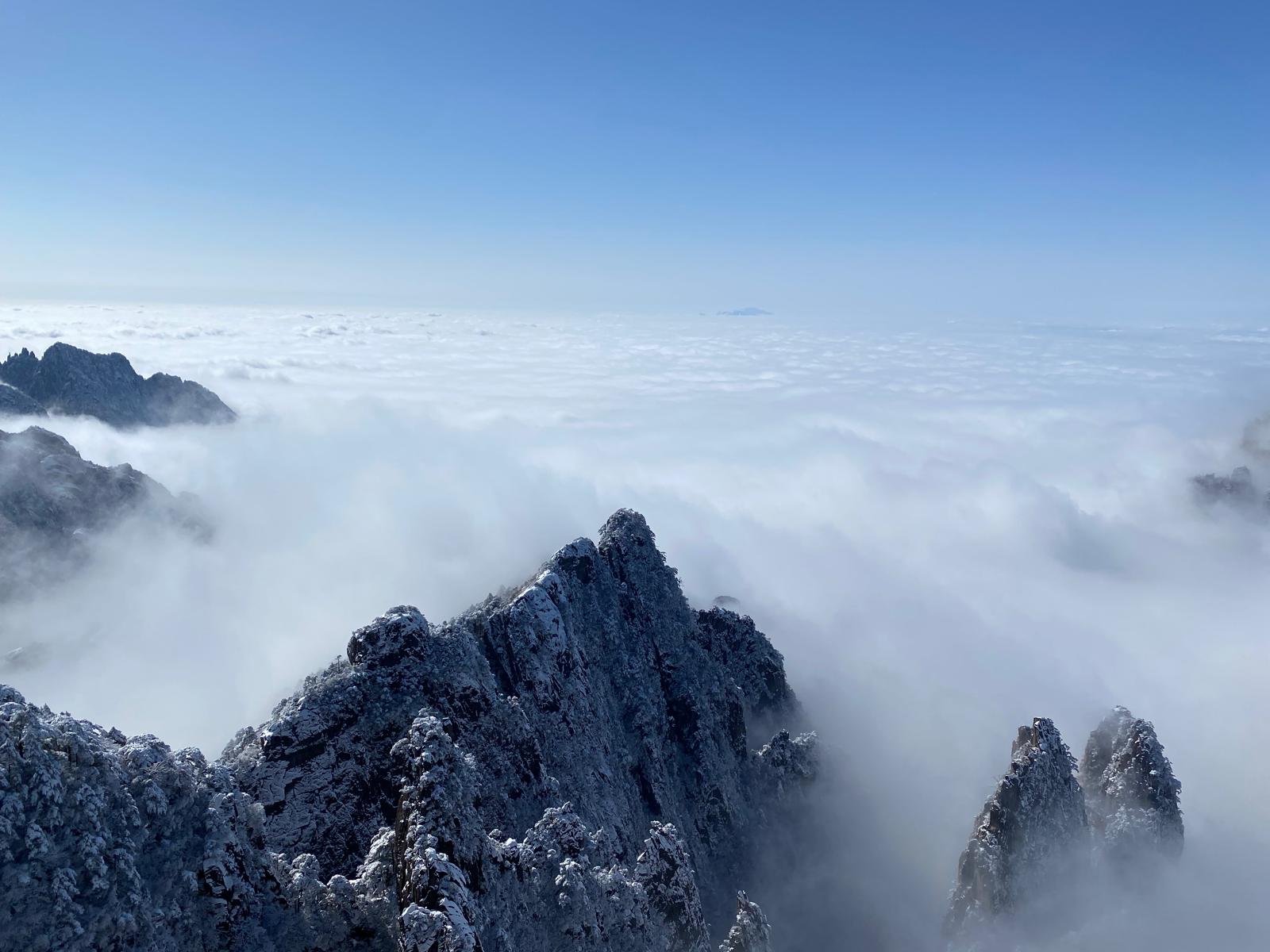All images courtesy of Cheng Yong (程勇)
The four “prime bodhisattvas” or “prime celestials” of Mahayana Buddhism – Avalokiteshvara (Guanyin), Manjushri (Wenshu), Kshitigarbha (Dizang), and Samantabhadra (Puxian) – enjoy a special presence in China, with pilgrimage spots far removed from their Indic origins marked out for them, including their own mountains.
Until this week, the most recent area where I had encountered with Manjushri’s power was when I was in Gansu Province during April. There, I’d visited the Ten Thousand Grottoes at Manjushri Mountain Grottoes, a little-known sanctuary in the chilly desert wilderness. Traditionally a much more popular and well known destination on the Chinese tourism map, the lush and gorgeous mountain range of Huangshan was the last place I would have expected to encounter Manjushri again.
If you have not been to Huangshan, go when there are fewer tourists in Anhui Province, like during chilly December. You’ll be able to enjoy a quieter cable car ride up to that collection of unmatched peaks. With a geological history of 800 million years, Huangshan is an exquisite work of nature’s elemental forces working in concert to form a symphony of integrated physical grandeur: grand forest landforms meet granite stones and caverns, with their host mountains reaching up from Earth to the heavens. These are jutting rock masses, colossi of both spherical and columnar weathering, with wild and curious shapes dominating across the joints and faces in all directions.

These peaks are in turn enveloped by what poets call a “sea of clouds” (yunhai). The pines on Huangshan are unique, growing in masses along its stony edges and ridges, and are called Pinus hwangshanensis. With springs, pools, glacier relics, creeks, and waterfalls caressing the mountains. It should be clear to all visitors why Huangshan is the premier range for all Chinese artists and poets.
The history of Huangshan, due to its incredible inaccessibility until very recent times, is patchy and infused with a sense of surreal mysticism. Before 747 CE it was known as Yishan, but it is not surprising why, during the Tang Dynasty, an imperial decree ordered that Huangshan become the range’s name for all time, because there was an apparent folkloric belief that the Yellow Emperor, the mythical ancestor of the Chinese, perfected the recipe for the pills of immortality there. So there was a native Daoist dimension, and the Li imperial family were devout supporters of Daoism. It was not until the early modern period, in 1606 (the same year of the Gunpowder Plot), when a Buddhist monk called Ven. Pumen (普门和尚) came to the mountain after having had a dream of Manjushri, who rather intriguingly claimed Huangshan as his dwelling on top of possessing Wutai Mountain.

Pumen went on to build the Fahai Buddhist Temple (UNESCO), which was later renamed by Emperor Wanli (1563–1620) as Huguo Ciguang Temple. It is natural that Huangshan, due to its unsurpassed beauty, has actually been claimed by Buddhist followers devoted to multiple figures and schools. The Chinese website, China Economic Net, says thus: “The bodhisattvas worshipped at Huangshan’s temples are different. To the south of Manjushri Monastery, there are the temples of Banshan, Ciguang, Ziyun, and so on. Most of the monks are disciples of Ven. Pumen and worship Manjushri Bodhisattva as the main seat.” (China Economic Net)
Manjushri Monastery itself was erected in 1613, not long after Ven. Pumen arrived to Huangshan. It was destroyed and rebuilt several times over the next few hundred years, until finally being burned down in 1955. Buddhist temples on Huangshan never enjoyed large scale support from merchants, let alone the state, during the Qing Dynasty (1644–1911). By 1949, many of the temples had been abandoned, fallen into a state of disrepair, or both.

In 1955, Huangshan Yupinglou Hotel was built over the ruins of Manjushri Monastery, and to its credit remains a fine establishment with excellent service and even better coffee. After enjoying a fine cappuccino in the restaurant with our guide, Cheng Yong (the longtime Anhui resident has been to Huangshan over a thousand times), he brought us to a cavern that is said to hold the presence of Manjushri. As it happens, this cavern is directly underneath the famed Greeting Pine (Yingkesong), which is also prominent from the viewing ledge near Yupinglou.
The Greeting Pine, over a millennium old and the subject of many artists’ paintings, is currently fenced off from human visitation due to its overwhelming popularity among tourists. These days, the cavern is more of a narrow passageway that has long been tamed by Huangshan management, but we were still able to squeeze ourselves in and sit on one of the rocks, chanting Manjushri’s mantra.
In the cavern and beyond, I felt the presence of not only the prime bodhisattva of wisdom, but also of his friends, Guanyin, and Samantabhadra. Why else might a monk (suspiciously named after the prime bodhisattva of enlightened action) have set up a watering hole for Manjushri, if not to gift his divine compatriot these marvellous peaks? Surely in the dream that Ven. Pumen had, Manjushri was manifesting or wishing for a sanctuary of such stunning beauty.
See more
Mount Huangshan (UNESCO)
黄山:文殊院佛教菩萨 (China Economic Net)
Related blog posts from BDG
The Caves of the Blazing Sword: Gansu Province’s Manjushri Mountain Grottoes

